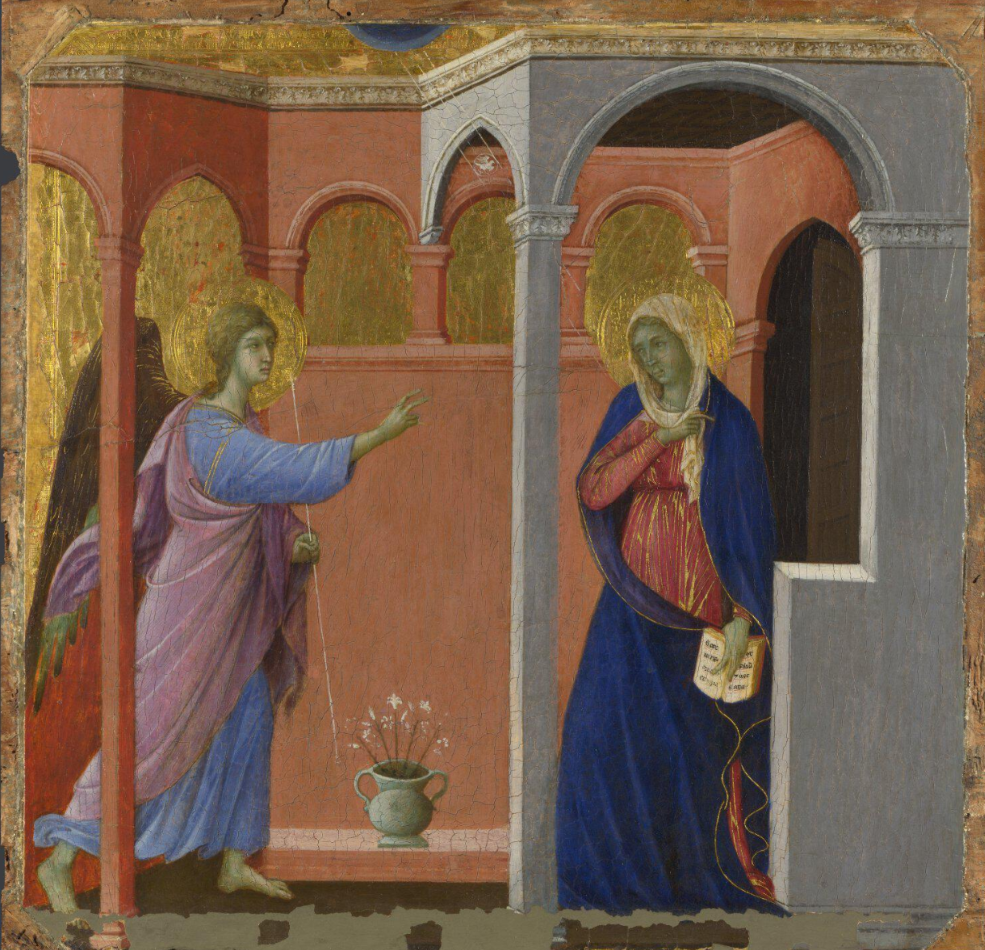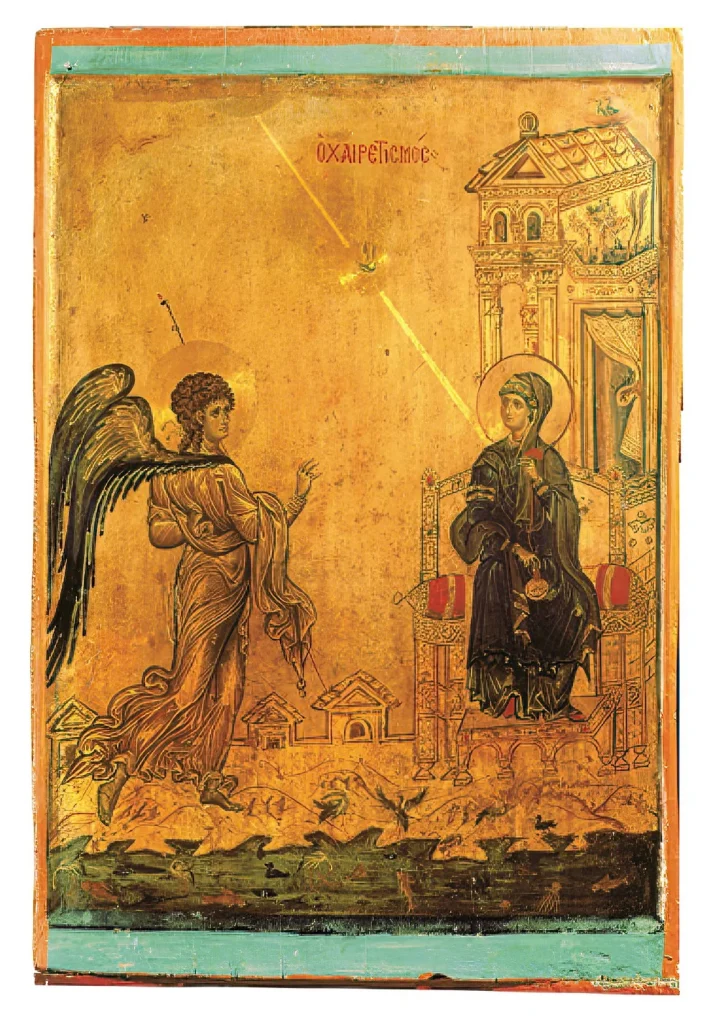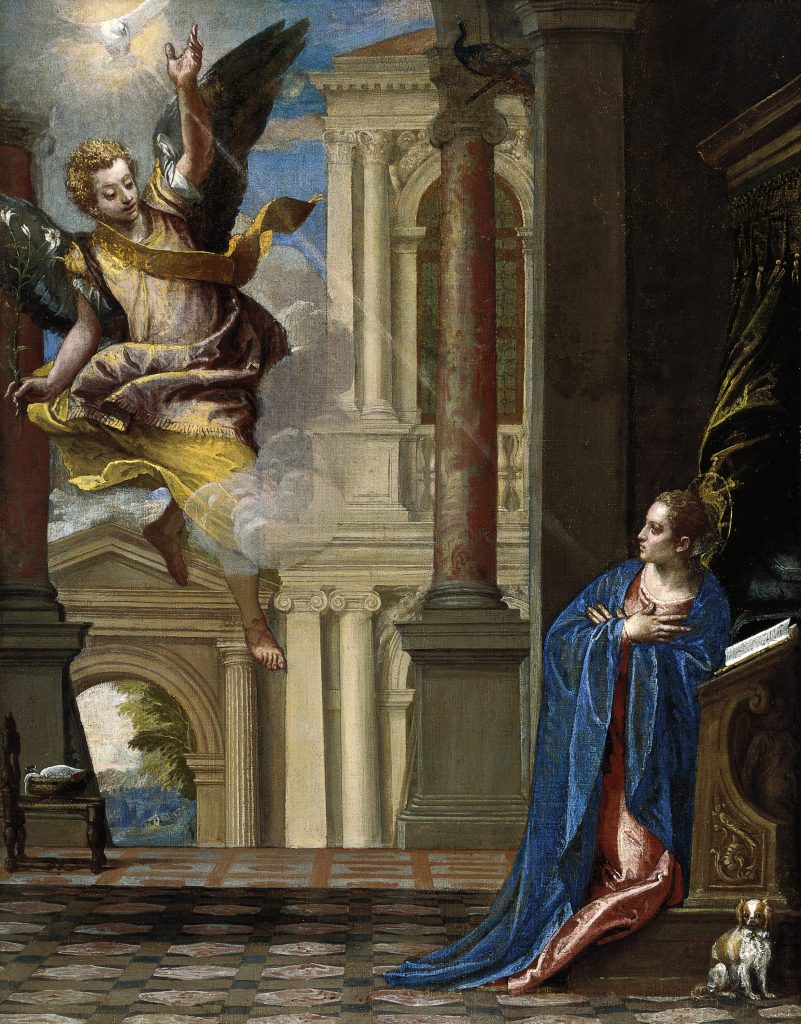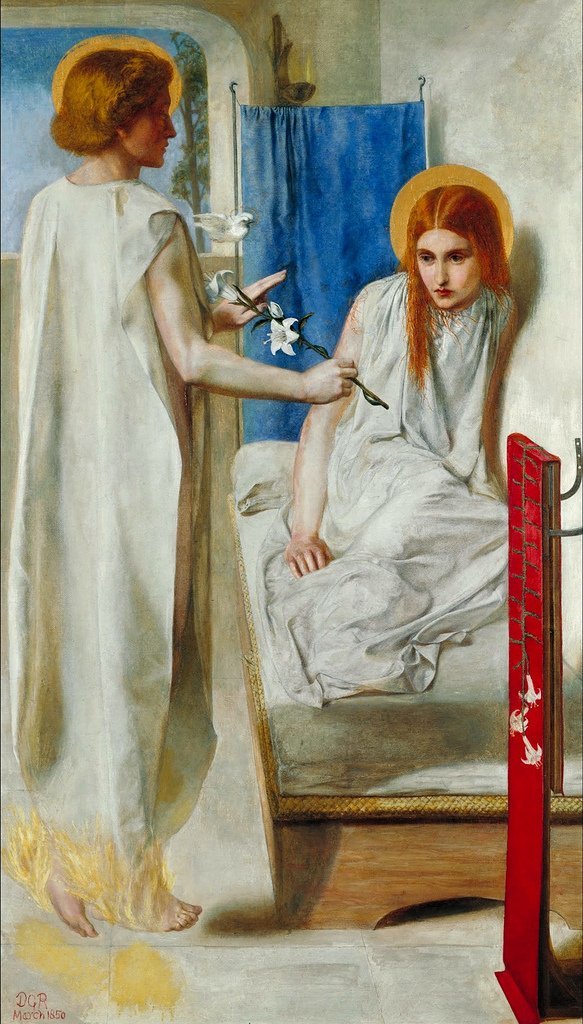
Today, is the anniversary of the conception of Jesus Christ. 9 Months before Christmas.
The picture above is by Duccio, from Sienna in Italy. It shows the Archangel Gabriel bringing Mary the news that she is to give birth to the Son of God. It is in the Sainsbury Wing of the National Gallery. I chose it to represent March 25th as it has a special meaning to me. When I suggested taking my groups to the National Gallery I was surprised to find myself agreeing to leading a tour of the Gallery. For an archaeologist to give an Art History Tour was a particular thrill. I decided the only way I could do it was to find a narrative thread to pull my tour together, and my choice was the development of perspective. I had been reading a book on the subject by David Hockney.
The painting shows that Duccio does not understand single-point perspective. But then, no one could do perspective at that time in Europe. This skill was lost following the Roman Period, but here at the beginning of the 14th Century, painters like Duccio from Sienna, and Giotto from Florence, were groping towards more realistic representation. You might say they wanted a more human depiction in which events are shown in spaces that are trying to look real, filled with more realistic looking people and beginning to show on their faces what can be interpreted as real emotions. Previously, the Byzantine style produced iconic, storytelling images, that were somewhat cartoon-like rather than realistic. Here, is an detail from one such, where there is little attempt to make the encounter seem real, in a real space between real people. But it does tell the story effectively.

Now, look at the Duccio, he uses the arcading at the top of the painting to give an impression of this being an encounter in a real space, and the Archangel Gabriel is moving through that space decisively. This is not just a picture with a story, this shows Duccio’s interest in capturing a fleeting but incredibly emotional moment. It happens to be the most important moment in the history of the world (from a Christian view point), the moment that the son of God is conceived as a human.
Gabriel is striding towards Mary, who has come out of her house to see him. He is just telling her ‘Hey, you are going to give birth to the Son of God.’ She looks overwhelmed, holding her arm protectively towards her. ‘What me?’ she might be saying but is also pointing at the Bible where this moment in time is predicted by Isaiah. Their faces are rounded, and realistic, Mary is clearly emotional. Also if you look at Gabriel’s feet he is quite well grounded unlike many other medieval paintings, where people often seem to be floating above the ground. Mary, too is firmly, anchored, although you cannot see her feet. It’s by no means ‘perfect’ because they don’t know the rules of perspective, not yet have discovered they could use lenses to develop the ability to do photorealistic portraits but they are searching for methods that can bring spaces and people towards realistic life. It mirrors a humanistic trend to see Mary not as sort of Goddess, but as a real mother.
Above the arcading can be seen a small sphere of blue sky from which emanates several ‘rays’ and a tiny Holy Dove. As I told the story, the rays are showing the moment of conception coming from Heaven to her womb which is hinted at by the red of her dress. The National Gallery commentary, which you can read here, suggests ‘The conception takes place at the moment she hears the words, which is why a tiny white dove, representing the Holy Ghost, flies towards her ear‘. This made me stop and think – the tiny dove is heading to her ear is it? Really? Why? Gabriel is the messenger saying the words, the words head to the ear. The Holy Dove is a symbol of the Holy Spirit, part of the Trinity of Father, Son and Holy Ghost. Its role, in the painting, is to show that God is the Father. So why, would the Holy Spirit enter by the ear?
I have been using a ruler to try to see if the National Gallery are right! It’s difficult to be sure with a reproduction. but my ruler says the rays from Heaven are neither heading to the ear not directly to the womb but in the general direction of her body. If they are right that the rays from heaven are heading for her ear, then is this rather the moment she is being told she will conceive rather than the moment of conception?
But the National Gallery text accepts that it is the moment of conception that is shown. So, I’ve looked at Luke 1:26-38:
‘Do not be afraid, Mary, for you have found favour with God. And now, you will conceive in your womb and bear a son, and you will name him Jesus.‘
On first reading he is telling her she will conceive, but reading it more carefully he is saying ‘now, you will conceive’. So Duccio is paying very careful attention to the Gospel and by the time Gabriel finishes his sentence she will have been impregnated by the Holy Dove.
Looking at other paintings of the Annunciation the rays from heaven/Holy Ghost head generally towards the virgin, sometimes to her head, nothing suggesting the ear. I’ve included a 19th Century Rossetti painting because it is so beautiful. It shows a lilly representing purity, instead of the rays, pointing to Mary’s womb.
By the way look at the feet in Rossetti’s painting. This is an early Rossetti painting, who was poet and I don’t think he yet had the skills to ground feet, but he takes advantage of it in this case and disguises his ineptitude by giving Gabriel fiery feet. Subsequently, Rossetti concentrated on paintings of women from the waist up. Since, first writing this, I have visited an exhibition of Rosetti’s drawings, and they show a very capable draughtsman. For more on March 25th. This page shows that, in fact, from a Christian perspective, March 25th is the most important day in history.


Discover more from And Did Those Feet
Subscribe to get the latest posts sent to your email.

Inspiring analysis of the evolution of the representations of a biblical moment.
Gives a key to read the paintings.
I love Rossetti’s!
Thank you. Yes there is something very special about the Rossetti – the primary colours dominated by white, and the vulnerability of Mary. If you google Rossetti paintings, and look in images, you will see very few have feet!
And I used to love giving that guided tour – standing in front of a great master and pontificating ……..